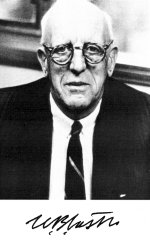William T. Astbury
George W. Beadle
John Desmond Bernal
William Lawrence Bragg
Herman R. Branson
Dan H. Campbell
William B. Castle
Robert B. Corey
Francis H. C. Crick
Max Delbrück
Emil Fischer
Frank Blair Hanson
Maurice Huggins
Harvey A. Itano
John C. Kendrew
Karl Landsteiner
Alfred E. Mirsky
Carl G. Niemann
Linus Pauling
Max F. Perutz
Frederick Sanger
S. Jonathan Singer
Theodor (The) Svedberg
Alexander R. Todd
Warren Weaver
Dorothy WrinchView all Key Participants
|

Portrait of William B. Castle, 1960s.
More Info
William B. Castle1897-1990
William B. Castle Papers, 1921-1987
Location: Center for the History of Medicine
Address: Francis A. Countway Library of Medicine, Longwood Medical Area, 10 Shattuck St. Boston,
Massachusetts 02115
Size: 4.6 cubic feet
Finding Aid: http://bit.ly/YHEPB0
Phone: 617-432-2170 Fax: 617-432-4737
Email: chm@hms.harvard.edu Web: https://www.countway.harvard.edu
Pictures and Illustrations
Quotes
"But after some years, at the end of the war, in connection with my interest in application
of chemistry to medicine, I learned about the disease sickle cell anemia. As soon
as I learned about this disease, the very evening - it was at a dinner in New York
where a medical research committee, of which I was a member, a committee which had
been appointed by President Roosevelt to study medical research in the United States,
was holding a meeting. At this dinner I learned about the disease sickle cell anemia
and immediately I thought, 'Could it be possible that this disease, which seems to
be a disease of the red cell because the red cells in the patients are twisted out
of shape, could really be a disease of the hemoglobin molecule?' Nobody had ever suggested
that there could be molecular diseases before, but this idea popped into my head.
I thought, 'Could it be that these patients manufacture a certain kind of hemoglobin
such that the molecules are sticky and clamp onto one another to form long rods which
then line up side-by-side to form a long, needle-like crystal which, as it grows inside
the red cell, becomes longer than the diameter of the cell and thus twists the red
cell out of shape.' Well, I said to the man who was talking about the disease, Dr.
Castle, 'Has anyone ever suggested that this might be a disease of the hemoglobin
molecule?' And he said not so far as he had ever heard and I said, 'Do you think it
would be alright if I were to look at the hemoglobin from these patients and see?'
And he said 'I don't see why not.' So when I got back to Pasadena, it turned out that
a young M.D., a young medical man wanted to come work with me in chemistry and get
his Ph.D. degree. I said to him - his name is Harvey Itano - I said to him 'Why don't
you work on the hemoglobin that you get from patients with the disease sickle cell
anemia and see whether it is the same as hemoglobin in other humans or its different?'
Nobody had ever found any difference between the hemoglobin of one person and another
before that time. Well Dr. Itano did that, together with the two other young men
in our laboratory - Dr. Singer and Dr. Wells. Pretty soon - it wasn't an easy job,
these proteins are hard substances to work with - but after a while Dr. Itano and
Dr. Singer and Dr. Wells were able to show that if they put a drop of hemoglobin solution
from a patient with this disease in a little trough containing salt solution and applied
an electric field - putting electrodes into this trough - the hemoglobin from the
sickle cell anemia patients would move in one direction in this trough and that from
ordinary individuals would move in the other direction. This was the proof that these
patients have a different kind of hemoglobin; they manufacture a special kind of hemoglobin
molecule which is the cause of their disease. This was the first molecular disease
to be identified, that is the first disease to be shown due to the manufacture by
the patient of an abnormal molecule."
Linus Pauling. National Film Board of Canada interview. 1960. |

